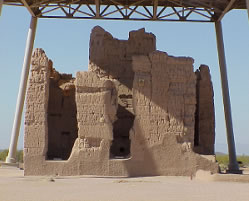
![]()
 |
| Casa Grande National Monument – built by the Hohokam Indians in the 14th century. |
|---|
Humans have been building shelter for thousands of years, so why are we now putting so much attention to the whole topic of building science? You’d think we figured out how to build houses the right way after so many years of practice.
After all, many of the most popular building principles and strategies we use in today’s homes and commercial buildings were originally developed by some primitive and ancient civilizations long ago, including:
- orienting buildings to capitalize on the sun’s pathway through the sky for light and heat
- selection and installation of materials that would shed water away from the structure, and
- storage of solar energy using high mass materials for use when needed.
Keep in mind that some Romans even had indoor plumbing and hot baths more than 2,000 years ago, so many of the ideas we think are fairly new have actually been around since the earliest civilizations.
The difference today, though, is that while people have been building for thousands of years, it is only during recent times that we have been able to achieve such a high level of control over our interior environments.
Technology has granted us the means, and we have come to expect more control over nearly everything in our environment that affects us, including individual comfort, ventilation, and even pests. Modern building science has provided us with very efficient windows, surfaces that reflect heat well, innovative insulation, and air tightening products and practices. We’ve learned, however, that even with “high tech” materials, some of these things just don’t perform well if they are not used as intended or are installed incorrectly.
Problems such as duct leakage or improper refrigerant charge in heat pumps can undermine the best attempts at having an energy-efficient home. Other problems often interfere with proper airflow distribution such as closing bedroom or office doors, which can result in pressure imbalances that increase infiltration, poor air quality and higher heating and cooling costs. Moisture problems can result for many reasons such as depressurized building spaces or poor air conditioning performance, and the causes of these problems are many and often very difficult to determine.
Building scientists must understand the complex nature of airflow within and across the building envelope, heat and moisture transfer to and from indoors, how these will affect the occupant, and how machines will impact the space and occupants.
Building science is similar to medical science in that though it has not been perfected, it provides an intelligent approach to understanding complex systems and diagnosing problems. Over time, improvements are made that make it even more useful. In the near future, more of the building industry will use building science principles as the way to build and commission excellent buildings. Go to the BAIHP web site to see some examples of building science in action within the building industry.
Creating an indoor environment that is healthy, comfortable, durable and energy efficient requires an understanding of the complex relationships between occupant, building, machines, and nature. Properly building a structure is indeed a science that deserves the attention it is getting today.
